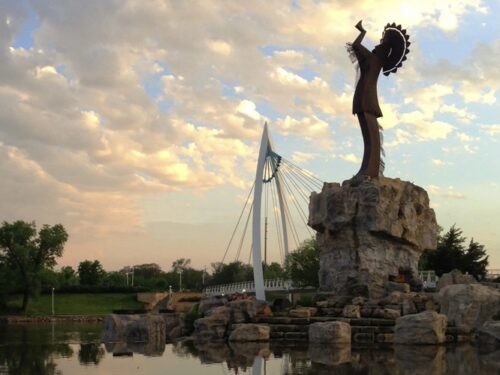
10.10.24 – KMUW | By Tom Shine
The annual Economic Outlook forecast from Wichita State University says a tight labor market will contribute to slower growth next year.
For a few years, the pandemic throttled Wichita’s economy.
But it has come roaring back the last two years.
Craig Compton says that’s about to end. He’s a research economist and project manager at Wichita State University’s Center for Economic Development and Business Research.
Compton delivered his economic forecast for Wichita on Thursday as part of the 45th annual Kansas Economic Outlook Conference at Century II.
He talked with Tom Shine about what’s ahead in 2025, the ongoing labor pinch and the overlooked contributions of agriculture to the local economy.
The interview was edited for length and clarity.
Tom Shine: Go ahead and give me the headlines out of this year’s forecast.
Craig Compton: So headlines out of this year’s book would be that we had some tremendous growth in 2023 and 2024, and we’re looking forward to more of that growth in 2025 and 2026. We’re just expecting it to slow down a little as things tighten up.
And really, it was also easy to have growth coming from where we were in 2020, and so we’re just seeing kind of reversion back to the more natural growth rate.
People have talked for the last few years that the economy nationally could fall into a recession. … But that’s never happened. Are we beyond the talk of recession now?
So, the term that some economists are using, myself included, is called a “vibecession.” And so it’s interesting because we don’t necessarily have data indicators for a recession, but lots of households are still feeling strained, still feeling some rising prices, and we saw that inflation creep up in March and come back down. And so even though it’s back down, people still have this sentiment that’s not necessarily driven in the real data, but it still does cause some hesitancy and this feeling that there is a potential recession. However, if you look at the underlying economic drivers and indicators, it would show signs of growth and health.

What’s the outlook for aerospace in Wichita in 2025?
So, aerospace in general, we do expect to see more growth, but we kind of expect the commonality of that slower growth trend. And so as we have these supply-chain issues and labor issues, we expect to see that it’s going to revert more toward its natural growth trend than our previous years of recovery and boom.
You mentioned in the forecast that Wichita will be hard-pressed to sustain its recent level of solid growth because the city has reached nearly full employment. Talk more about that situation.
So, the general economic consensus is that a location reaches full employment when it ranges around 3 to 4% on that unemployment rate. And so in 2024, we saw 3.7% unemployment. And then we expect that to continue on in 2025 and 2026, and that’s just an indicator of the labor market and the fact that it’s tightening up a little bit. So, firms are really struggling to find labor, and they’re really competing for individuals out there in the labor force.
So, where does Wichita find workers in the future, in ’25 and ’26 and ’27? Where are they going to come from?
So, likely, what we’re seeing across the country – but especially in the state of Kansas – we’re seeing this rural out-migration, where large swaths of people are moving from rural communities into more urbanized communities. So, we definitely expect to see some of that migration, and then we’ll also have internal population booms … as our younger populations age into the workforce.
The report says per capita income statewide is expected to grow slightly to about $71,000. But you indicate that that doesn’t really fare that well nationally, and that hurts growth in Kansas. How so?
So, when we look at the income, we have to take into account inflation. And so inflation right now, it’s hovered anywhere between 3% to about 3.5%.
When you look at that, we would need a more substantial wage growth to compensate for that. And so, unfortunately, the rates that we’re looking at right now aren’t quite enough to get us above that level.
Do we have people perhaps leaving the state then for jobs elsewhere that are paying more?
That is certainly a side effect of this consequence. But because of our currently tight labor market, one of the upshots of this is that we have firms that are competing for laborers, and that’s driving up the price of wages and putting that upward pressure on wages. So, we hope that that will continue to increase and make those wages closer to the inflation.
When you were putting together your report, was there something in there that surprised you?
So, the most surprising thing would be the performance of agriculture in 2023. Original projections for that year weren’t necessarily as strong as they were, especially considering that ag (gross domestic product) increased by 125% in 2023, and that’s largely due to some of the high commodity prices, like beef, soy, wheat.
Obviously that’s a significant statistic where, if you look at our charts by industry, they generally range 1 to maybe 10%. So, that’s just such a robust amount of growth.
We live, obviously, in a major city. Do we sometimes underestimate the impact of agriculture on the state’s economy?
We definitely do underestimate it frequently, especially considering ag processing and food manufacturing is such an important part of the Wichita economy. We’ve got lots of different food manufacturers in town. And Wichita is kind of a food capital; we’ve got Pizza Hut, White Castle, we’re famous for Freddy’s. And as this kind of bastion of food, part of that supply chain is agriculture. And so I think it’s important that we continue to value agriculture’s role in our urban society.

Tom joined KMUW in 2017 after spending 37 years with The Wichita Eagle where he held a variety of reporting and editing roles. He also is host of The Range, KMUW’s weekly show about where we live and the people who live here. Tom is an adjunct instructor in the Elliott School of Communication at Wichita State University.
